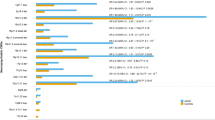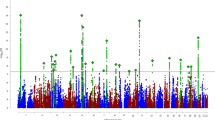Abstract
Attention deficit hyperactivity disorder (ADHD) is a childhood onset disorder, for which there is good evidence that genetic factors contribute to the aetiology. Recently reported linkage findings suggested evidence of a susceptibility locus on chromosome 16p13 (maximum LOD score of 4.2, P=5 × 10−6). The GRIN2A (glutamate receptor, ionotropic, N-methyl D-aspartate 2A) gene that encodes the N-methyl D-aspartate receptor subunit 2A (NMDA2A) maps to this region of linkage. As this is also a good functional candidate gene for ADHD, we undertook family-based association analysis in a sample of 238 families. We found significant evidence of association with a GRIN2A exon 5 polymorphism (χ2=5.7, P=0.01). Our data suggest that genetic variation in GRIN2A may confer increased risk for ADHD and that this, at least in part, might be responsible for the linkage result on 16p reported by Smalley et al. We conclude that replication is required and that further work examining for association of GRIN2A polymorphisms with ADHD is warranted.
This is a preview of subscription content, access via your institution
Access options
Subscribe to this journal
Receive 12 print issues and online access
$259.00 per year
only $21.58 per issue
Buy this article
- Purchase on Springer Link
- Instant access to full article PDF
Prices may be subject to local taxes which are calculated during checkout
Similar content being viewed by others
References
Nakanishi S, Nakajima Y, Masu M, Ueda Y, Nakahara K, Watanabe D et al. Glutamate receptors: brain function and signal transduction. Brain Res Brain Res Rev 1998; 26: 230–235.
Williams NM, Bowen T, Spurlock G, Norton N, Williams NJ, Hoogendoorn B et al. Determination of the genomic structure and mutation screening in schizophrenic individuals for five subunits of the N-methyl-D-aspartate glutamate structure. Mol Psychiatry 2002; 7: 508–514.
Melzer H, Gatward R, Ford T . Mental Health of Children and Adolescents in Great Britain. The Stationery Office: London, 2000.
Barkley RA . Attention-Deficit Hyperactivity Disorder, 2nd edn. The Guilford Press: New York, 1998.
Thapar A . Attention deficit hyperactivity disorder: new genetic findings, new directions. In: Behavioural Genetics in the Postgenomic Era. Plomin R, DeFries J, Craig I, McGuffin P (eds) APA, 2002.
Fisher SE, Francks C, McCracken JT, McGough JJ, Marlow AJ, MacPhie IL et al. A genomewide scan for loci involved in attention-deficit/hyperactivity disorder. Am J Hum Genet 2002; 70: 1183–1196.
Carlsson ML . On the role of cortical glutamate in obsessive-compulsive disorder and attention-deficit hyperactivity disorder, two phenomenologically antithetical conditions. Acta Psych Scand 2000; 102: 401–413.
Gainetdinov RR, Mohn AR, Bohn LM, Caron MG . Glutamate modulation of hyperactivity in mice lacking the dopamine transporter. Proc Natl Acad Sci USA 2001; 98: 11047–11054.
Mohn AR, Gainetdinov RR, Caron MG, Koller BH . Mice with reduced NMDA receptor expression display behaviors related to schizophrenia. Cell 1999; 98: 427–436.
Ikeda K, Araki K, Takayama C, Inoue Y, Yagi T, Aizawa S et al. Reduced spontaneous activity of mice defective in the epsilon 4 subunit of the NMDA receptor channel. Brain Results Mol Brain Resol 1995; 33: 61–71.
Sakimura K, Kutsuwada T, Ito I, Manabe T, Takayama C, Kushiya E et al. Reduced hippocampal LTP and spatial learning in mice lacking NMDA receptor epsilon 1 subunit. Nature 1995; 373: 151–155.
Smalley SL, Kustanovich V, Minassian SL, Stone JL, Ogdie MN, McGough JJ et al. Genetic linkage of attention-deficit/hyperactivity disorder on chromosome 16p13, in a region implicated in autism. Am J Hum Genet 2002; 71: 959–963.
Holmes J, Payton A, Barrett JH, Hever T, Fitzpatrick H, Trumper AL et al. A family-based and case–control association study of the dopamine D4 receptor gene and dopamine transporter gene in attention deficit hyperactivity disorder. Mol Psychiatry 2000; 5: 523–530.
Berument SK, Rutter M, Lord C, Pickles A, Bailey A . Autism screening questionnaire: diagnostic validity. Br J Psychiatry 1999; 175: 444–451.
Norton N, Kirov G, Krawczak M, Williams NM, O'Donovan M, Owen M . Universal, robust, highly quantitative SNP allele frequency measurement in DNA pools. Hum Genet 2002; 110: 471–478.
Chen X, Levine L, Kwok PY . Fluorescence polarization in homogenous nucleic acid analysis. Genome Res 1999; 9: 492–498.
Clayton D . A generalization of the transmission/disequilibrium test for uncertain haplotype transmission. Am J Hum Genet 1999; 65: 1170–1177.
Castellanos FX . Neuroimaging studies of ADHD. In: Stimulant Drugs and ADHD. Basic and Clinical Neuroscience. Solanto M, Arnsten A, Castellanos F (eds). Oxford University Press: Oxford, 2001, pp 243–258.
Rubia K, Taylor E, Smith AB, Oksannen H, Overmeyer S, Newman S . Neuropsychological analyses of impulsiveness in childhood hyperactivity. Br J Psychiatry 2001; 179: 138–143.
Castellanos FX, Lee PP, Sharp W, Jeffries NO, Greenstein DK, Clasen LS et al. Developmental trajectories of brain volume abnormalities in children and adolescents with attention-deficit/hyperactivity disorder. JAMA 2002; 288: 1740–1748.
Carlsson M, Carlsson A . Interactions between glutamatergic and monoaminergic systems within the basal ganglia — implications for Schizophrenia and Parkinsons-disease. Trends Neurosci 1990; 13: 272–276.
Grace AA . Psychostimulant actions on dopamine and limbic system function: relevance to the pathophysical and treatment of ADHD. In: Stimulant Drugs and ADHD. Basic and Clinical Neuroscience. Solanto M, Arnsten A, Castellanos F (eds). Oxford University Press: Oxford, 2001, pp 134–157.
Horikawa Y, Oda N, Cox NJ, Li X, Orho-Melander M, Hara M et al. Genetic variation in the gene encoding calpain-10 is associated with type 2 diabetes mellitus. Nat Genet 2000; 26: 163–175.
Rioux JD, Daly MJ, Silverberg MS, Lindblad K, Steinhart H, Cohen Z et al. Genetic variation in the 5q31 cytokine gene cluster confers susceptibility to Crohn disease. Nat Genet 2001; 29: 223–228.
Bray NJ, Buckland P, Owen MJ, O'Donovan MC . Cis-acting mechanisms affect the expression of a high proportion of genes in human brain, submitted.
Acknowledgements
This work is supported by the Wellcome Trust. Jane Holmes, Tracey Hever and Helen Pay were involved in the first wave of data collection. We thank all the clinicians and especially all the families who participated in this study.
Author information
Authors and Affiliations
Corresponding authors
Rights and permissions
About this article
Cite this article
Turic, D., Langley, K., Mills, S. et al. Follow-up of genetic linkage findings on chromosome 16p13: evidence of association of N-methyl-D aspartate glutamate receptor 2A gene polymorphism with ADHD. Mol Psychiatry 9, 169–173 (2004). https://doi.org/10.1038/sj.mp.4001387
Received:
Revised:
Accepted:
Published:
Issue Date:
DOI: https://doi.org/10.1038/sj.mp.4001387
Keywords
This article is cited by
-
Are there links between Alzheimer’s disease and ADHD? The efficacy of acetylcholinesterase inhibitors and NMDA receptor antagonists in controlling ADHD symptoms: a systematic review
Middle East Current Psychiatry (2024)
-
Genetic Intersections of Language and Neuropsychiatric Conditions
Current Psychiatry Reports (2020)
-
Cellular and Molecular Changes in Hippocampal Glutamate Signaling and Alterations in Learning, Attention, and Impulsivity Following Prenatal Nicotine Exposure
Molecular Neurobiology (2020)
-
Exploring characteristic features of attention-deficit/hyperactivity disorder: findings from multi-modal MRI and candidate genetic data
Brain Imaging and Behavior (2020)
-
Disrupted Glutamatergic Transmission in Prefrontal Cortex Contributes to Behavioral Abnormality in an Animal Model of ADHD
Neuropsychopharmacology (2017)



